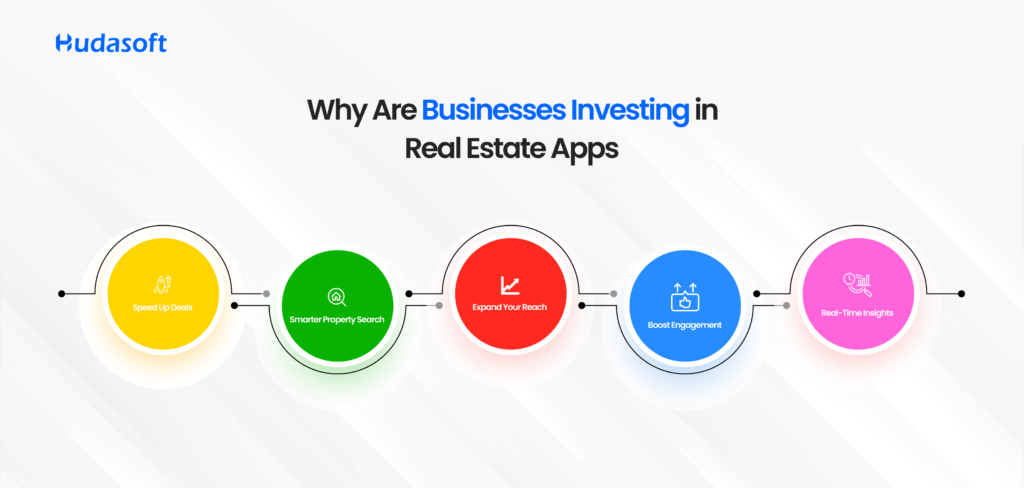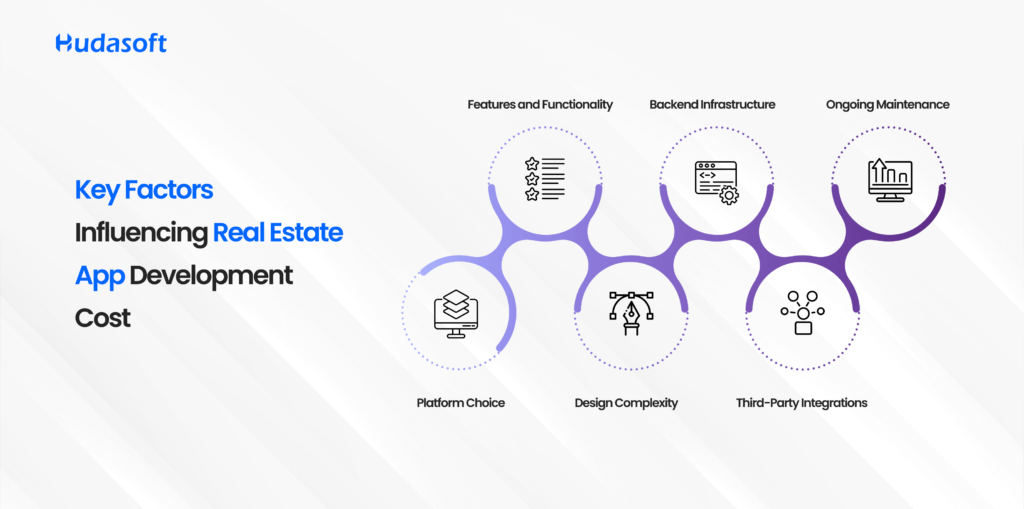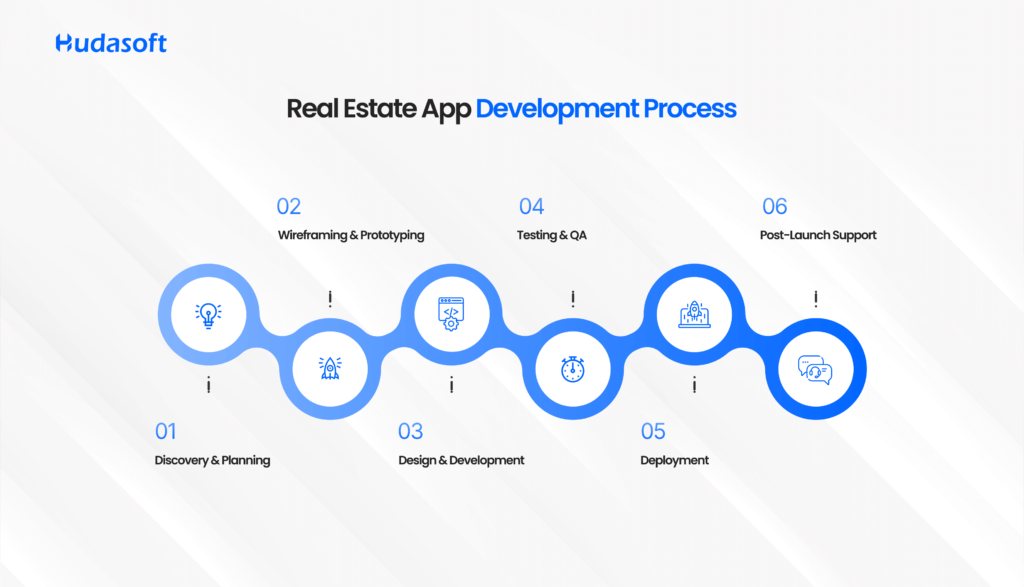Table of Contents
Let’s face it, in today’s market, technology is no longer optional; it’s essential. Whatever your business may be, developing a mobile app can completely change how you operate and serve clients.
Naturally, businesses are rapidly investing in real estate mobile applications to gain a competitive edge.
So naturally, the big question becomes:
What is the real estate app development cost in 2025?
Let’s walk through everything you need to know, from market trends and cost breakdowns to smart ways you can save money on development without cutting corners.
The Growing Real Estate Tech Market
The numbers speak for themselves. The global real estate tech market is on track to hit $94.2 billion by 2030, and mobile app usage is a huge part of that.
In the US alone, real estate app downloads have jumped 15%.
Buyers want speed. Sellers want exposure. Agents want automation. And apps make all of that possible.
Why Are Businesses Investing in Real Estate Apps

We’re reaching the point where you must have a real estate mobile app to remain competitive and keep pace with the interest in the market. There is a huge demand for real estate mobile apps, and rightfully so.
1. Speed Up Deals
Nobody wants to chase agents across 10 emails and 5 phone calls. Apps let buyers book viewings, message agents, and even manage documents all in one place. That means faster closings and happier clients.
2. Smarter Property Search
Advanced filters, AI recommendations, and saved searches — modern apps help people find exactly what they’re looking for, and they remember user preferences, so your app gets more helpful over time.
3. Expand Your Reach
An app gives you 24/7 visibility. You’re not just showing properties locally — you’re tapping into a global audience of buyers and investors. And with push notifications and promotions, you’re always top of mind.
4. Boost Engagement
From 360° virtual tours to in-app messaging, real estate apps keep users engaged. That stickiness turns into loyalty, and that loyalty turns into referrals.
5. Real-Time Insights
Your app collects data that helps you understand user behavior: which properties get clicks, when users drop off, and what filters they use most. That means smarter decisions and better marketing.
Bottom line? A real estate app isn’t just a tool — it’s a growth engine.
Key Factors Influencing Real Estate App Development Cost

Let’s talk about the actual cost of building one of these apps.
Here’s the thing: there’s no one-size-fits-all price tag. Just like no two properties are the same, no two apps cost the same either. Your app’s price will largely depend on its complexity, the features you want, and who you hire to build it especially when choosing between basic tools and full-scale real estate app development services tailored to your business needs.
Let’s break it down:
1. Platform Choice
- iOS, Android, or both?
Building a native app for each platform is more expensive, but it gives you better performance. - Want to save costs?
Go with a cross-platform framework like Flutter or React Native. You get one codebase that runs on both platforms — pretty handy for MVPs.
2. Features and Functionality
- A basic app might just include property listings, search filters, and a contact form.
- But if you’re planning to offer AI-driven recommendations, 3D tours, or digital document signing, expect the budget to go up.
3. Design Complexity
Design isn’t just about making things “look nice” — it impacts usability and trust.
- Minimalist UI? Cheaper.
- Custom animations, branding, and interactive maps? That’s going to cost more.
4. Backend Infrastructure
Think of this as the engine running behind the scenes.
- You’ll need secure databases, admin dashboards, user authentication, and more.
- If you’re syncing listings in real time or handling thousands of users, you’ll need solid cloud infrastructure.
5. Third-Party Integrations
You probably don’t want to build everything from scratch.
Plug in things like:
- Google Maps
- Payment gateways (Stripe, PayPal)
- CRM platforms
- MLS databases
Each of these adds cost, not just in setup, but often ongoing subscription fees too.
6. Ongoing Maintenance
Building the app is just the beginning.
- You’ll need updates, bug fixes, OS upgrades, and security patches.
Most teams charge 15–20% of the original development cost per year for ongoing support.
Average Real Estate App Development Costs
Here’s a rough idea of what different types of Real Estate apps cost in 2025:
| App Type | Estimated Cost (USD) |
| Basic App | $30,000 – $50,000 |
| Mid-Level App | $50,000 – $120,000 |
| Enterprise App | $150,000 – $300,000+ |
And here’s how the budget might break down:
- Design – 10–15%
- Development – 40–50%
- Testing & QA – 10–15%
- Deployment – 5%
- Ongoing Maintenance – 15–20% annually
Looking for a reliable team to streamline these processes and bring your app idea to life? Hudasoft’s app development services combine industry expertise with cost-effective delivery.
Cost to Develop an App Like REX Real Estate
REX Real Estate positioned itself as a modern alternative to traditional brokerages. Instead of relying on human brokers, REX used automation, data analysis, and software applications to streamline buying and selling.
If you’re aiming to build a modern real estate platform similar to REX, you’ll need a solid feature set.
Key Features of Enterprise-Level Apps like REX
- AI-Driven Property Recommendations
Advanced algorithms analyze buyer behavior, and market data to suggest properties that match their needs more.
- Virtual Tours
Interactive 3D tours and property visuals allow buyers to explore homes remotely. - CRM Functionalities
Integrated customer relationship management tools enable real-time communication between agents, buyers, and sellers, while also managing leads, appointments, and client interactions. - Transaction Management
End-to-end digital solutions handle everything from document signing to payment processing and escrow coordination, reducing paperwork and speeding up closings.
Here’s what your estimated Real Estate app development cost might look like:
| Component | Cost Estimate (USD) |
| Frontend | $15,000 – $25,000 |
| Backend | $20,000 – $40,000 |
| AI & ML Integration | $25,000 – $50,000 |
| Third-party APIs | $10,000 – $20,000 |
| Total | $70,000 – $135,000+ |
Must-Have Features For a Successful Real-Estate App
A great real estate app isn’t just functional, it’s intuitive, efficient, and built to keep users engaged.
You don’t need every bell and whistle at launch, but here are the features buyers and agents expect in an MVP:
- Easy user registration
Quick, seamless sign-up keeps users engaged and lets them access personalized property matches every time they return. - Property listings with detailed info and media
Makes it easy to upload, edit, and organize listings without hassle. - Smart search filters
Helps users instantly narrow down listings to exactly what they’re looking for. This seamless experience keeps users satisfied. - Virtual tours / 3D walkthroughs
Gives buyers a real feel of properties from anywhere, saving time on in-person visits. - Booking and calendar integration
Lets users instantly book property viewings and get reminders—no back-and-forth needed. - Built-in CRM tools
Helps agents track leads, manage conversations, and close deals faster—all in one system. - In-app chat or messaging
Keeps buyer–agent chats streamlined and accessible without switching to email or WhatsApp. - Push notifications (new listings, status updates)
Sends real-time alerts about new listings, updates, or meeting reminders to keep users engaged. - Analytics & reporting
Offers data-driven insights to improve listings, track user behavior, and boost conversions.
- Admin panel
Gives your internal team full control over users, listings, and platform performance from one dashboard.
Real Estate App Development Process

Here’s your exact step-by-step plan to launch the real estate app to your business needs.
1. Discovery & Planning
Define your app’s purpose, audience, and business goals. This is where budget, timeline, and key features are outlined.
2. Wireframing & Prototyping
Map user journeys, screen flows, and interactions before development starts. Visualize how users will navigate the app.
3. Design & Development
Here’s where your app starts coming to life. Craft the look, feel, and user experience of the app. Create intuitive designs that guide user behaviour.
4. Testing & QA
Before launching, the app goes through multiple rounds of testing — both manual and automated — to catch bugs, improve speed, and ensure everything works on different devices.
5. Deployment
Time to launch!
Run extensive testing to fix bugs and ensure smooth performance. Once stable, publish to App Store, Google Play, or the web.
6. Post-Launch Support
Launching isn’t the end — it’s the start of real-world feedback. You’ll need regular updates, bug fixes, security patches, and maybe even new features over time.
How to Optimize Real Estate App Development Cost
- Start with an MVP: Focus on must-have features; scale later.
- Choose the right development team: Offshore teams offer savings.
- Leverage pre-built components: Save time and cost.
- Use cloud platforms: Reduce infrastructure management.
- Adopt Agile methodology: Deliver in sprints and avoid scope creep.
Hidden Costs to Watch Out For
- App store submission and renewal fees
Annual developer fees for Apple and Google.
- Cloud hosting and server costs
Scalable infrastructure like AWS or Firebase incurs monthly charges.
- Paid third-party services
Map APIs, analytics tools, and CRMs may require subscriptions.
- Marketing and customer acquisition
Advertising and promotions can significantly impact the budget.
- Legal and compliance fees
Meeting standards like GDPR or ADA can require audits and expert guidance.
Conclusion
Before you dive into development, getting a clear picture of the real estate app development cost is essential. Pricing can swing significantly depending on the app’s features, platform choice, and overall complexity.
But there’s good news; with the right strategy, you can stretch your budget further, speed up your timeline, and get more value from your investment.
Whether you’re building a basic property listings app or a feature-rich platform like REX, having a solid roadmap and the right development team by your side can make all the difference.
FAQs
How much does it cost to develop a real estate app?
Anywhere from $30,000 to $300,000+, depending on features and complexity.
What is the cost to develop an app like REX Real Estate?
Expect to invest $70,000 to $135,000+ for a platform with AI and advanced features.
What features increase the cost of real estate app development?
AI integrations, 3D tours, CRM modules, and secure document handling are major contributors.
Can I build a real estate app on a budget?
Yes. Starting with an MVP and selecting a skilled offshore team can keep costs manageable.
How long does it take to develop a real estate app?
Typically 3 to 9 months, depending on scope and team size.
Leave a Reply